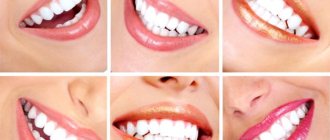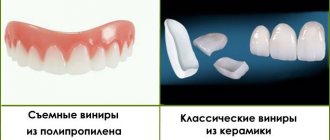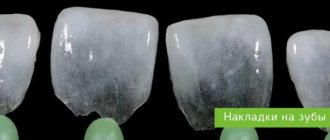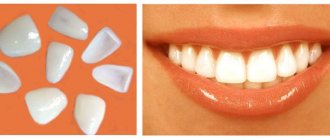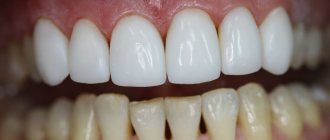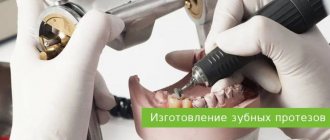Author of the article:
Anastasia Vorontsova
Photo: Computer modeling method
To install veneers, you will need to visit the dental clinic at least twice.
At the first visit, the doctor will prepare the tooth for installation of the onlay, take an impression, select the required color, depending on the color of the patient’s other teeth, and install a temporary veneer.
After one to two weeks, the patient will need a second visit to the dentist, during which the doctor will try on the manufactured veneer and fix it on the tooth.
Materials
Veneers are made from different materials, with ceramic and composite materials being the most popular.
The choice of material is one of the most important stages in the manufacture of veneers.
Modern composite materials are used to manufacture structures using the direct method.
In this case, it is best to give preference to materials that are the most reliable: not subject to abrasion, color-fast, have a wide range of colors, and are well polished.
Scope of application of veneers
Modern dentistry has begun to resort to veneering teeth as an alternative to installing all-ceramic crowns. Making veneers is much simpler, takes less time and costs patients significantly less. Porcelain veneers are created in a laboratory (indirect method) and serve to improve the aesthetics of teeth.
Using veneers you can:
- hide any types of tooth enamel defects:
- fluorosis spots;
- changed color due to treatment with tetracycline;
- darkening of the enamel resulting from dental treatment using old methods or due to injury;
Manufacturing technique and method
Methods for making veneers can be systematized as follows:
- Layer-by-layer application. The veneer is made on platinum foil, which is pressed around a ground tooth on a plaster model. The foil holds the ceramic mass applied to it during firing in the kiln. The dental technician applies the ceramic and fires it directly on the model itself. The good thing about this technique is that it allows you to reduce distortion and shrinkage, as well as the cost of the technology.
- Casting method (injection pressing). Modeling of wax overlays is carried out on a working model, after which they are installed on the sprue and packaged in a special fire-resistant mass. Under vacuum conditions at a very high temperature, after burning the wax, a frame is formed from a ceramic or glass block under pressure. After pressing (casting), the finished plates are painted in the required color. This technique simplifies the process of making veneers and is characterized by high accuracy and excellent marginal fit. Photo: CAD/CAM technology
- Computer modeling using CAD/CAM technologies. The advantage of this technology is that the workpiece can be milled, fitted and fixed in one visit to the doctor. The process of milling the overlay takes no more than ten minutes. The structure is sawed off from the shank, after which it is fitted, polished and glazed. The finished structure is fixed on the tooth with a self-hardening material. Veneers can also be made remotely. The dentist receives an optical impression from the prepared tooth and sends the virtual model to the milling shop by email. After the veneer is made, it is delivered to the clinic by express mail.
Features of making veneers using the direct method
The thickness of the structure manufactured by direct method and manufactured in the laboratory is significantly different.
- The thickness of the veneer made using the direct method depends on the degree of expression of the tooth color.
- The lighter the tooth, the thinner the veneer, and vice versa.
- Consequently, the depth of tooth grinding is determined individually by the doctor and depends on the condition of the patient’s tooth.
The advantage of a veneer made using the direct method is that it is made on the day of visiting the dentist, which is very convenient for patients.
Features of ceramic veneers
Ceramic veneers are one of the most popular dentures. This type of lining has a number of positive aspects. They are installed on the front teeth, but before you decide on this procedure, you should be examined by a doctor, as there are a number of contraindications.
Advantages of ceramic veneers:
- For installation, tooth removal is not required. This allows you to preserve the process of trophism of hard tissues.
- Ceramics is an environmentally friendly material.
- Ceramic products can last more than 10 years.
- Thanks to the light transmission properties, teeth covered with such plates look as natural as possible.
- Products can be installed on cutters.
- With proper care, the material does not lose its shine and does not turn yellow.
Ceramic veneers can be installed on both older and younger people. They are also given to patients who are allergic to other materials. An equally important advantage of ceramic dentures is that if there are defects, they can be easily replaced with new ones. To remove the plate, a laser is used or the cutting method is used with a diamond bur. Veneers can be attached to one tooth or to several at once. The number of products is chosen by the client himself.
Unfortunately, the installation of products cannot be carried out if there are crowns and bulk fillings on the outer part of the tooth. Also, the plates are not intended for attachment to artificial teeth.
Manufacturing and installation
Veneers go through the following stages of manufacturing and installation:
- The initial patient appointment usually includes taking an anamnesis, clarifying complaints, examination, and instrumental examination of the teeth.
- The condition of the gums and plaque is assessed.
- If necessary, X-ray and laboratory tests are performed.
The next step is planning, which involves researching factors such as:
- Gender, age, character of the patient.
- The smile and facial shape are assessed.
- The shape of the line of the gingival margin of the patient’s anterior group of teeth is studied.
- The individual characteristics of the tooth, shape, position, location of contact points, and the direction of the tooth axes are assessed.
- The initial parameters of the restored and intact teeth are measured.
- The size of the veneers is predicted and calculated.
- Demonstration of future restoration on a computer monitor.
Before starting the restoration, it is necessary to carry out professional teeth cleaning and only after that select the color of the veneers being made.
Dental care with veneers
The service life of a veneer is more than 10 years, provided proper care and systematic checks by a dentist. Experts recommend:
- Clean your teeth daily using a brush and floss to avoid the occurrence of caries in veneered teeth;
- Avoid excessive force on teeth with veneers - do not bite your nails, do not bite threads, do not crack nuts, etc. Otherwise, it is difficult to avoid the porcelain plate being displaced or broken.
Aesthetic dentistry from the Interdentos dental laboratory provides for the production of ceramic veneers at attractive prices.
Installation steps
Photo: Veneers on a plaster model
- Cleaning the tooth surface from plaque. Products that do not contain oils and fluoride are used.
- Selection of the required shade of filling material.
- Grinding of the front surface of the tooth with preliminary anesthesia. The required amount of enamel is removed from the surface of the tooth. The depth of enamel grinding depends on the thickness of the veneer overlay.
- Taking impressions. To take dental impressions, a special spoon is used, on which a special paste is applied, then the spoon is pressed against the teeth until the mass hardens.
- Based on the dental impressions obtained, a plaster model is cast in the laboratory to obtain an exact copy of the patient’s teeth.
- Making a veneer using a cast plaster model.
- After the doctor has prepared the teeth, a temporary veneer is made directly in the office.
- Trying on the finished veneer after its manufacture. If necessary, adjustments are made, deficiencies are eliminated, and the bite is checked.
- The tooth and veneer are washed under running water and dried with air. Then, to increase the strength of fixation of the plate to the tooth, the doctor etches the enamel with a special gel. Only after this is the veneer fixed to the tooth using special cement.
Cleaning teeth from plaque
Photo: Cleaning teeth from plaque before installing veneers.
It is a must when carrying out any types of restorations.
- Cleansing is performed with a special paste that gently cleanses the tooth of plaque and plaque.
- The dentist applies the paste to a rotating standard polishing disc or brush and cleans.
- To prevent heating, the paste is taken in large quantities.
- In this case, saliva is a kind of saliva ejector.
- After treatment with the paste, the tooth is thoroughly rinsed with water.
Ignoring this procedure leads to a fairly rapid formation of plaque around the lining and pigmented border.
Selecting the shade of filling material
With the patient in a sitting position, the color of the filling material is selected in natural light.
The tooth and reference should be wet when choosing the color, which gives them a natural look.
The choice of shade should be made in natural light.
Tools and equipment for tooth preparation
High-quality grinding of a tooth before covering it with veneer requires the use of modern, highly functional dental equipment.
- The preparation unit must have water-air cooling, a tip washing system, a fiber optic device, a scaler, a 270° rotation of the control panel around the chair, an air-water gun and a control unit for three tips.
- The spittoon must be equipped with an air vacuum group: a dust and saliva ejector, and a built-in clean water system.
- The presence of a lighting device - a reflector, creating a uniform illuminated field with clear boundaries.
- Equipping the dental chair with a silent electromechanical lift makes it possible to treat the patient in a lying position with four hands.
What are veneers and what are they made from?
Veneers are ceramic plates installed on the outer surface of teeth in order to restore (create) the aesthetics of a smile. This restoration method refers to microprosthetics. If the teeth are miniature and there are gaps between them, then dentures can be installed without turning, only by treating the enamel to improve adhesion. In all other cases, the teeth along the front and side surfaces need a little gentle grinding. Therefore, subsequently removing the veneer and leaving the tooth “as is” will not work. You will need to either fix a new veneer or install a full-fledged prosthesis - a crown.
The thickness of the microprosthesis is 0.5 - 0.7 mm. When installed correctly, it fits tightly to the surface of the dental element and does not allow pathogenic microflora to penetrate there. Veneers are generally made from a durable ceramic alloy. It is hypoallergenic and biocompatible with body tissues. Sometimes plates are made of composite or zirconium, but ceramics, according to experts, has more reliable strength characteristics and is aesthetically identical to natural teeth.
Note: the color and shape of the veneers are selected using a special computer program using real photographs of the patient. This allows you to see the result before the actual installation of the records.
Benefits of porcelain veneers
Veneers, compared to other types of dental restorations, have two main advantages:
Porcelain veneers give the tooth a natural appearance. Until recently, all materials used by dentists to improve the appearance of restored teeth were opaque or translucent. This means that light, hitting the surface of such materials, was immediately reflected from their surface without penetrating deep into it, which did not allow achieving a complete resemblance to natural teeth. Porcelain veneers are transparent and this is their main advantage compared to all other materials.
Porcelain is a ceramic, glass-like material that is smooth and completely impenetrable, so there will be no stains or discoloration on its surface.
Service life of veneers
Depending on the manufacturing method, the service life of the finished product may vary. Thus, direct veneers can last up to 7 years, but after 2-3 years the aesthetic properties of such microprostheses deteriorate.
Ceramic veneers can last up to 20 years if properly cared for. It must be remembered that the service life of the product may be reduced if the structure is improperly manufactured and fixed. Therefore, it is worth contacting competent specialists. It should also be noted that you cannot “over-wear” the veneers, since after the expiration of their service life there is a risk of the plate falling out.
Veneers are a high-tech development with which you can quickly and easily get a perfect smile. The technology for manufacturing microprostheses is being improved from year to year, which makes it possible to reduce the degree of filing of the tooth surface, while obtaining excellent results.
Historical reference
Composite materials are modified plastics with improved aesthetic, strength and handling properties. Their connection with tooth tissues is due to adhesion.
Adhesion (Latin adhesio - fusion, adhesion) is the phenomenon of adhesion between two surfaces brought into contact. Systems created on the basis of this phenomenon are widely used in dentistry.
Currently, there are seven generations of these systems , with the fourth to seventh being used in clinical practice. They differ from each other in adhesion strength, the relationship of the components (separately or in combinations) and indications for use.
The widespread use of veneers dates back to the 1980s.
Advantages and disadvantages of lumineers
Advantages and disadvantages of lumineers
Benefits of using lumineers
- Gentle method (the principle of preserving healthy tissue);
- No need to make temporary restorations;
- The ability to achieve maximum aesthetic results with minimal impact on the hard tissues of the tooth.
Disadvantages of Lumineers
- Inability to radically change tooth color;
- A change in tooth shape is not always indicated;
- Plaque can accumulate at the lumineer-tooth interface and pigmentation and enamel caries can develop;
- The edge of the lumineer “hangs” over the gum, which can lead to the development of inflammatory periodontal diseases - gingivitis and periodontitis;
- Lumineers are very fragile due to their thinness (up to 0.3 mm) and require extremely careful handling at all stages - from manufacturing to use (unreliability of the design).
